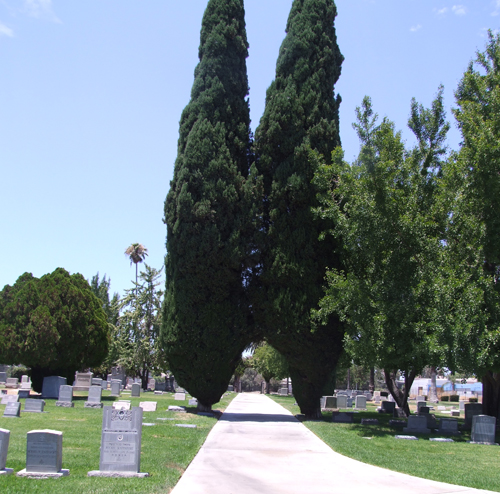
–Fifth in a series–
By Donald H. Harrison
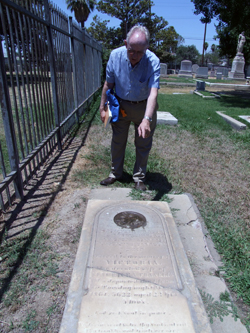
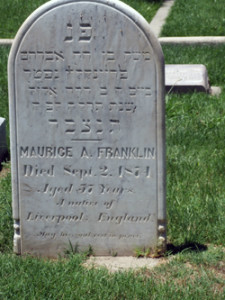
SAN BERNARDINO, California –As grandson Shor and I continued our tour up the Interstate 15 from Riverside, it seemed only a matter of minutes until we reached San Bernardino, site of the oldest Jewish cemetery in continuous use in Southern California.
The Home of Eternity, at 8th and Sierra Way, was conveyed in 1861 to Marcus Katz, who had lived in San Bernardino for nine years as the second Jew to arrive in the inland California town. The acre of land was located adjacent to the Pioneer Memorial Cemetery which served the general population. Unfortunately, it did not lay fallow for very long. Children such as Amelia Wolff who died at age 4 were the earliest burials, and Victoria Jacobs Franklin, a young bride who had been well known in San Diego, became in late 1861 the first adult to be buried, at the age of 22.
Victoria, the daughter of Marks Jacobs of San Diego, had married Maurice Franklin, an Englishman who in partnership with his brother Lewis ran the three-story Franklin Hotel on the Plaza in Old Town San Diego. Victoria and Lewis so disliked each other that Victoria refused to come down from her room to eat dinner if she knew that Lewis would be present. The brothers had an acrimonious split, which resulted in a court case that seemingly everybody in town attended—so little else was there to do for entertainment in early San Diego. After the court divided the two brothers’ property, Maurice and Victoria moved to San Bernardino. Maurice, who died in 1875, also is buried at the Home of Eternity. Before she married Maurice, Victoria kept a diary of her life in San Diego, which provided valuable information about San Diego’s pioneer days, especially because it was annotated by historian Sylvia Arden.
A false legend grew up around the second adult to be buried in San Bernardino’s Jewish cemetery, 24-year-old Wolff Cohn. Some untrue accounts said that he had been scalped by Indians, but in fact he died as a bystander to a gunfight at his brother’s haberdashery store.
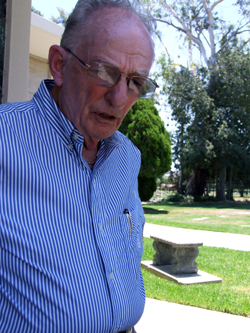
Shor and I were escorted around the cemetery by Rabbi Hillel Cohn, spiritual leader of Congregation Emanu-El, which had its origins in San Bernardino but now, to better serve its membership, is located in the city of Redlands. The Reform congregation administers the cemetery, which passed from the ownership of Marcus Katz to the local lodge of the B’nai B’rith, and then ultimately to the congregation.
Until earlier this year, Hillel Cohn was the rabbi emeritus of Congregation Emanu-El, having served on the pulpit from 1963 to 2001. He returned from retirement to serve once again as the congregation searches for a permanent rabbi.
Walking us through the cemetery—where he and his wife have their plots, “the only move we ever plan on making,” Rabbi Cohn says—he paused here and there at various graves to tell some stories and, it seemed, to visit, however briefly, with some old friends.
At the grave of Jacob Rich, who died in 1872, Cohn credited the merchant with having brought to San Bernardino its first Torah, which Congregation Emanu-El is in possession of to this very day.
At a centennial celebration for the congregation, a new Torah was commissioned and a Satmar Chasid from New York was engaged to be the sofer. As part of the ceremonies, the new Torah was brought to the congregation in a reenactment of how Rich brought his – with the sofer sitting in a Wells Fargo stagecoach and cradling the Torah in his lap. Cohn paraphrased the sofer, Moishe Klein, as saying that it was one of the most exciting moments of his life.
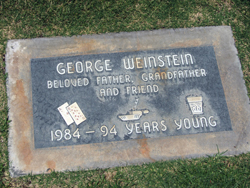 The marker on one grave indicated that George Weinstein had died at the age of 94. The symbols on the grave were playing cards, cigars and whiskey—apparently disputing the idea that gambling, smoking and boozing will shorten lives.
The marker on one grave indicated that George Weinstein had died at the age of 94. The symbols on the grave were playing cards, cigars and whiskey—apparently disputing the idea that gambling, smoking and boozing will shorten lives.
At another set of graves, Cohn noted that the wife was Jewish but the husband wasn’t. On the wife’s grave were logos of various organizations to which she belonged, including the PTA, Pioneer Women, City of Hope, Hadassah, and the Stamp Club. When the husband, an electrician, died he placed the union symbol on his grave, but he also wanted something to denote his Catholic faith. The synagogue permits non-Jewish spouses to be buried in the cemetery, but without the rituals or symbols of any other religion. A call from the monument maker asked if a cross could be put on the stone, and Cohn said no. Could they indicate his baptismal date? No, not that either. Could they say the church he was blessed at? Still no.
Finally the stone was set and the inscription read “Blessed by God at 509 E 26th St, Erie, Pennsylvania.” That, said Cohn, was the address of St. Mark’s Church. And if you look carefully at the Tree of Life symbol on the gravestone, the trunk and lower branches look like a cross, although the monument maker denies that was the intent.
A note of modern San Diego Jewish interest: Harold and June Berk, father and stepmother of Rabbi Michael Berk of San Diego’s Congregation Beth Israel, are buried side-by-side at the Home of Eternity.
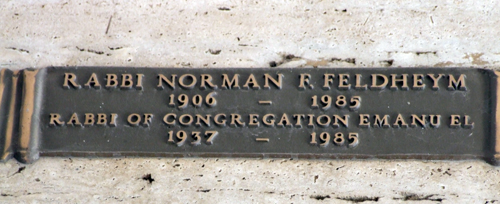
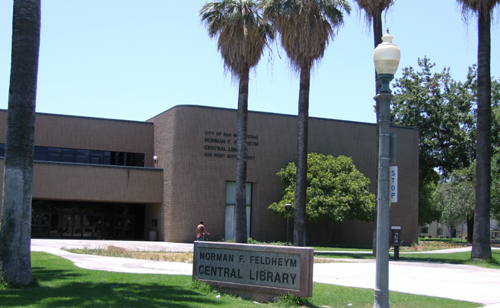
Congregation Emanu-El, which serves people belonging to various streams of Judaism, maintains a mausoleum as well as a columbarium at the Home of Eternity. Among those whose bodies are entombed is Rabbi Norman Feldhym who was Rabbi Cohn’s predecessor and for six years his co-rabbi before Feldhym’s retirement.
Besides being a Jewish leader, Feldhym was a civic leader, serving as the head of the City of San Bernardino’s library commission. Today, San Bernardino’s new library is named for Feldhym. It was just a short ride from the cemetery to the library and then back to the Interstate 15 to resume our northbound journey.
*
Harrison is editor of San Diego Jewish World. He may be contacted via donald.harrison@sdjewishworld.com